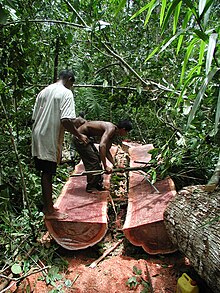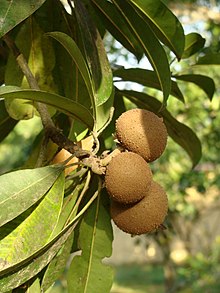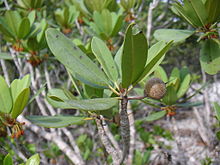Manilkara
| Manilkara | ||||||||||||
|---|---|---|---|---|---|---|---|---|---|---|---|---|

Pear Apple Tree ( Manilkara zapota ) |
||||||||||||
| Systematics | ||||||||||||
|
||||||||||||
| Scientific name | ||||||||||||
| Manilkara | ||||||||||||
| Adans. |
Manilkara is a genus of plants in the sapotaceae family. It iswidespreadin the tropics . Some species use the wood, the milky sap and / or the fruit as fruit. Some species such as Manilkara gonavensis in Haiti and Manilkara spectabilis in Costa Rica are endangered, while other species are threatened and are on the IUCN's Red List of Endangered Species.
description

Vegetative characteristics
Manilkara species grow as trees and bushes. They contain milk juice . The bark is woolly or hairy.
The alternate often standing in rosette-like clusters on the ends of branches leaves are divided into petiole and leaf blade. The leathery leaf blades are simple with a rounded to wedge-shaped base and a blunt to pointed top. The leaf surfaces are hairy or glabrous. There are usually numerous parallel, less noticeable side nerves. There are either no stipules or they fall off early.
Generative characteristics
The long-stalked flowers sit in fascicles or, less often, individually in leaf axils or on bare nodes . The mostly hermaphrodite flowers are radial symmetry and mostly threefold. There are two unequal circles, usually three, less often two (only in one species) or four sepals ; they are often densely hairy on the outside. The mostly six petals are fused with tubes at their base and each petal ends seemingly deep three-lobed but has two appendages. The six fertile stamens are relatively short and start at the upper end of the corolla tube. The anthers are relatively short with a length of about 1.5 mm. The fertile stamens alternate with the six bald, corolla-like, upright or curved staminodes or, more rarely, other fertile stamens. Six to 14 carpels are at a bare or frequently fluffy hairy, Upper permanent, six- to 14-kammerigen ovary grown.
The bald, ellipsoidal to more or less spherical, fleshy berries contain one or more (up to ten) seeds. The laterally flattened (brown) seeds contain plenty of endosperm . The hilum is linear.
distribution
The genus Manilkara is widespread in the tropics . They occur from Florida via Mexico , via Central America and the Caribbean Islands to South America , as well as in Asia , Africa and Madagascar , as well as on the Pacific islands . About 15 species occur in Africa. There are only two species in North America , both only in Florida.
Systematics
The genus Manilkara was established in 1763 by Michel Adanson in Familles des Plantes (Adanson) , 2, p. 166, 574. Type species is Manilkara kauki (L.) Dubard . Synonyms for Manilkara Adans. are: Achras L. , Chiclea Lundell , Eichleria Hartog , Mahea Pierre , Manilkariopsis (Gilly) Lundell , Mopania Lundell , Murianthe (Baill.) Aubrév. , Muriea Hartog , Murieanthe (Baill.) Aubrév. , Nispero Aubrév. , Northiopsis Kaneh. , Sapota Mill. , Shaferodendron Gilly , Stisseria Scop. , Synarrhena fish. & CAMey. The genus Manilkara belongs to the tribe Sapoteae in the subfamily Sapotoideae within the family Sapotaceae .






The genus Manilkara includes (depending on the author about 50 to) about 80 species:
- Manilkara adolfi-friederici (Engl. & K.Krause) HJLam : It occurs in Zaire .
- Manilkara bequaertii (De Wild.) HJLam : It occurs in Zaire .
- Balata tree ( Manilkara bidentata (A.DC.) A.Chev. ): It occurs in two subspecies from Panama and the islands of the Caribbean to tropical South America.
- Manilkara boivinii Aubrév. : It occurs in northern and eastern Madagascar.
- Manilkara bolivarensis T.D.Penn. : It occurs in Venezuela.
- Manilkara butugi Chiov. : It occurs from Ethiopia to Tanzania.
- Manilkara capuronii Aubrév. : It occurs in northwestern Madagascar.
- Manilkara casteelsii (De Wild.) HJLam : It occurs in Zaire .
- Manilkara cavalcantei Pires & Rodr. ex TDPenn. : It occurs in Brazil.
- Manilkara celebica H.J.Lam : It occurs on Sulawesi .
- Manilkara chicle (Pittier) Gilly : It occurs from Mexico to Colombia.
- Manilkara concolor (Harv.) Gerstner : It occurs from Mozambique to South Africa.
- Manilkara dardanoi Ducke : It occurs in Brazil.
- Manilkara dawei (Stapf) Chiov. : It occurs from Congo to northwestern Tanzania.
- Manilkara decrescens T.D.Penn. : It occurs in Brazil.
- Manilkara discolor (Sond.) JHHemsl. : It occurs from Kenya to southern Africa.
- Manilkara dissecta (Lf) Dubard : It occurs on islands in the southwestern Pacific.
- Manilkara doeringii (Engl. & K.Krause) HJLam : It occurs in Togo .
- Manilkara dukensis (Engl. & K.Krause) HJLam : It occurs in Cameroon.
- Manilkara elata (Allemão ex Miq.) Monach. : It occurs in Brazil.
- Manilkara excelsa (Ducke) Standl. : It occurs in Brazil.
- Manilkara excisa (Urb.) HJLam : It is endemic to the tropical karst known as the Cockpit Karst in Jamaica . In 1998 it was classified as “Endangered” by the IUCN.
- Manilkara fasciculata (Warb.) HJLam & Maas Geest. : It occurs from eastern Borneo to northern New Guinea.
- Manilkara fischeri (Engl.) HJLam : It occurs in Tanzania.
- Manilkara fouilloyana Aubrév. & Pellegr. : It occurs from tropical West Africa to tropical Central Africa.
- Manilkara frondosa (here) HJLam : It occurs in Angola.
- Manilkara gonavensis (Urb. & Ekman) Gilly ex Cronquist : Little is known about this species. She was found in Haiti. In 1998 it was classified as “Critically Endangered” by the IUCN.
- Manilkara hexandra (Roxb.) Dubard : It is native to China, Vietnam, Cambodia, Thailand, Nepal, India and Sri Lanka. It is cultivated in some countries.
- Manilkara hoshinoi (Kaneh.) P.Royen : It occurs on the Carolines .
- Manilkara huberi (Ducke) Standl. : It occurs from northern South America to Brazil.
- Manilkara ilendensis (Engl.) HJLam : It occurs in Cameroon.
- Manilkara inundata (Ducke) Ducke : It occurs from western South America to Brazil.
- Manilkara jaimiqui ( C. Wright ex Griseb.) Dubard : With four subspecies in Florida, the Bahamas and the Greater Antilles.
- Manilkara kanosiensis H.J.Lam & B.Meeuse (Syn .: Manilkara napali P.Royen ): It occurs from Maluku to New Guinea.
- Manilkara kauki (L.) Dubard : It occurs from Indochina to northern Australia.
- Manilkara koechlinii Aubrév. & Pellegr. : It occurs in the Republic of the Congo .
- Manilkara kribensis (Engl.) HJLam : It occurs in Cameroon.
- Manilkara kurziana H.J.Lam & B.Meeuse : It occurs in Myanmar.
- Manilkara letestui Aubrév. & Pellegr. : It occurs in Gabon.
- Manilkara letouzei Aubrév. : It occurs from southern Cameroon to the Republic of the Congo .
- Manilkara littoralis (short) Dubard : It occurs from the Andaman, Nicobar and Bangladesh to Thailand.
- Manilkara longifolia (A.DC.) Dubard : It occurs in Brazil.
- Manilkara longistyla (De Wild.) CMEvrard : It occurs in Zaire .
- Manilkara lososiana Kenfack & Ewango : It occurs in Cameroon.
- Manilkara mabokeensis Aubrév. : It occurs in tropical West and Central Africa.
- Manilkara maxima T.D.Penn. : It occurs in Brazil.
- Manilkara mayarensis (Ekman ex Urb.) Cronquist : It is endemic to the eastern part of Cuba . In 1998 it was classified as “Endangered” by the IUCN.
- Manilkara microphylla Aubrév. & Pellegr. : It occurs from Gabon to the Republic of the Congo .
- Manilkara mochisia (Baker) Dubard : It occurs from Somalia to southern Africa.
- Manilkara multifida T.D.Penn. : It occurs in Brazil.
- Manilkara nicholsonii A.E. van Wyk : It occurs in KwaZulu-Natal.
- Manilkara obovata (Sabine & G.Don) JHHemsl. : It occurs in tropical Africa.
- Manilkara paraensis (Huber) Standl. : It occurs from northern South America to Brazil.
- Manilkara pellegriniana Tisser. & Sillans : It occurs from Cameroon to the Republic of the Congo.
- Manilkara perrieri Aubrév. : It occurs in eastern Madagascar.
- Manilkara pleeana (Pierre ex Baill.) Cronquist : It occurs from Puerto Rico to the Virgin Islands .
- Manilkara pobeguinii Pierre ex Dubard : It occurs in Guinea.
- Manilkara pubicarpa Monach. : It occurs in Guyana.
- Manilkara roxburghiana (Wight) Dubard : It occurs in southern India.
- Manilkara rufula (Miq.) HJLam : It occurs in northeastern Brazil.
- Manilkara sahafarensis Aubrév. : It occurs in northern Madagascar.
- Manilkara salzmannii (A.DC.) HJLam : It occurs in Brazil.
- Manilkara samoensis H.J.Lam & B.Meeuse : It occurs in Samoa .
- Manilkara sansibarensis (Engl.) Dubard : It occurs from Kenya to Mozambique.
- Manilkara seretii (De Wild.) HJLam : It occurs in Zaire.
- Manilkara sideroxylon (Griseb.) Dubard : It occurs in eastern Cuba and Jamaica.
- Manilkara smithiana H.J. Lam & Maas Geest. : It occurs in the Fiji Islands.
- Manilkara spectabilis (Pittier) Standl. It is only known from a single site near Limón in Costa Rica . Since this lowland rainforest was largely destroyed, it was classified as "Critically Endangered" in 1998 by the IUCN.
- Manilkara staminodella Gilly : It occurs in Central America.
- Manilkara suarezensis Aubrév. : It occurs in northern Madagascar.
- Manilkara subsericea (Mart.) Dubard : It occurs in southern Brazil.
- Manilkara sulcata (Engl.) Dubard : It occurs from southern Somalia to Tanzania.
- Manilkara Sylvestris Aubrév. & Pellegr. : It occurs in the Ivory Coast .
- Manilkara triflora (Allemão) Monach. : It occurs in Brazil.
- Manilkara udoido Kaneh. : It occurs on the Carolines .
- Manilkara valenzuelana (A.Rich.) TDPenn. : It occurs in Cuba, Hispaniola and maybe also in Costa Rica.
- Manilkara vitiensis (HJLam & Olden) B.Meeuse : It occurs on the Fiji Islands.
- Pear apple tree ( Manilkara zapota (L.) P.Royen ): It is originally distributed from Mexico to Central America, but is now also found in Florida and on the Caribbean islands.
- Manilkara zenkeri Lecomte ex Aubrév. & Pellegr. : It occurs from Cameroon to the Republic of the Congo.
use
For example, Manilkara celebica , Manilkara fasciculata , Manilkara hexandra , Manilkara kanosensis provide wood that is traded under the names sawo (ID), sawah (MY), duyok-duyok (PH), sner (PG), khayah rgn (MM). It is not protected by CITES regulations . The dense and hard wood is processed into bridge piles, wheel spokes, posts, railway sleepers, etc.
Non-elastic rubber is obtained from the milky sap of some Manilkara species. The extract from the seeds has been used as an anthelmintic and eye medicine.
swell
- Henri Alain Liogier : Descriptive Flora of Puerto Rico and Adjacent Islands . tape 4 . La Editorial, 1995, ISBN 978-0-8477-2337-9 , pp. 141-144 . Google Book Online.
- MA Hyde, BT Wursten, & P. Ballings, 2011: Entry in the Flora of Zimbabwe .
- Shugang Li & TD Pennington: Sapotaceae in the Flora of China : Volume 15, 1996, p. 206: Manilkara - Online. (Section description)
- Richard P. Wunderlin & R. David Whetstone: Manilkara in the Flora of North America : Volume 8, 2009, p. 234: Online. (Section description)
- Kamal Akhter Malik: Manilkara in the Flora of Pakistan : Online. (Section description)
- FK Kupicha: Sapotaceae in Flora Zambesiaca , Volume 7, 1983: Manilkara - Online.
Individual evidence
- ↑ Enter "Manilkara" in the search mask at IUCN.
- ↑ First publication scanned at biodiversitylibrary.org .
- ^ Manilkara at Tropicos.org. Missouri Botanical Garden, St. Louis
- ↑ Manilkara in the Germplasm Resources Information Network (GRIN), USDA , ARS , National Genetic Resources Program. National Germplasm Resources Laboratory, Beltsville, Maryland.
- ↑ a b c d e f g h i j k l m n o p q r s t u v w x y z aa ab ac ad ae af ag ah ai aj ak al am an ao ap aq ar as at au av aw ax ay az ba bb bc bd be bf bg bh bi bj bk bl bm bn bo bp bq br bs bt Rafaël Govaerts (Ed.): Manilkara. In: World Checklist of Selected Plant Families (WCSP) - The Board of Trustees of the Royal Botanic Gardens, Kew . Retrieved June 4, 2020.
- ↑ Manilkara excisa in the endangered Red List species the IUCN 2011. Posted by: World Conservation Monitoring Center, 1998. Retrieved on last September 28, 2011.
- ↑ Manilkara gonavensis in the endangered Red List species the IUCN 2011. Posted by: World Conservation Monitoring Center, 1998. Retrieved on last Sept. 28, 2011.
- ↑ Manilkara mayarensis in the endangered Red List species the IUCN 2011. Posted by: Areces-Mallea, AE, 1998. Retrieved on last September 28, 2011.
- ↑ Manilkara spectabilis in the endangered Red List species the IUCN 2011. Posted by: World Conservation Monitoring Center, 1998. Retrieved on last September 28, 2011.
- ↑ Entry in Timber from DELTA.
- ^ A b Richard P. Wunderlin & R. David Whetstone: Manilkara in der Flora of North America : Volume 8, 2009, p. 234: Online.

